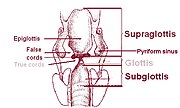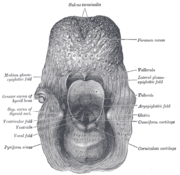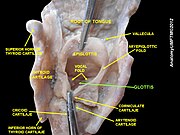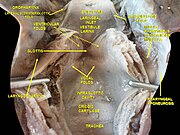Glottis
| Glottis | |
|---|---|
 Arytenoid cartilage | |
Glottis positions | |
| Identifiers | |
| MeSH | D005931 |
| TA98 | A06.2.09.012 |
| TA2 | 3197 |
| FMA | 55414 |
| Anatomical terminology | |
The glottis (pl.: glottises or glottides) is the opening between the vocal folds[1] (the rima glottidis).[2] The glottis is crucial in producing sound from the vocal folds.
Etymology
[edit]From Ancient Greek γλωττίς (glōttís), derived from γλῶττα (glôtta), variant of γλῶσσα (glôssa, "tongue").[3]
Function
[edit]Phonation
[edit]As the vocal folds vibrate, the resulting vibration produces a "buzzing" quality to the speech, called voice or voicing or pronunciation.
Sound production that involves moving the vocal folds close together is called glottal.[4] English has a voiceless glottal transition spelled "h". This sound is produced by keeping the vocal folds spread somewhat, resulting in non-turbulent airflow through the glottis.[4] In many accents of English the glottal stop (made by pressing the folds together) is used as a variant allophone of the phoneme /t/ (and in some dialects, occasionally of /k/ and /p/); in some languages, this sound is a phoneme of its own. This is the case with the Klingon language developed for the science fiction series Star Trek, which treats the glottal stop as its own letter, represented by the apostrophe.[5]
Skilled players of the Australian didgeridoo restrict their glottal opening in order to produce the full range of timbres available on the instrument.[6]
The vibration produced is an essential component of voiced consonants as well as vowels. If the vocal folds are drawn apart, air flows between them causing no vibration, as in the production of voiceless consonants.[7]
The glottis is also important in the Valsalva maneuver.
- Voiced consonants include /v/, /z/, /ʒ/, /d͡ʒ/, /ð/, /b/, /d/, /ɡ/, /w/.
- Voiceless consonants include /f/, /s/, /ʃ/, /t͡ʃ/, /θ/, /p/, /t/, /k/, /ʍ/, and /h/.
Additional images
[edit]References
[edit]- ^ Ladefoged, Peter. 2006. A course in Phonetics. UCLA.
- ^ WebMD (2009). "glottis". Webster's New World Medical Dictionary (3rd ed.). Houghton Mifflin Harcourt. p. 178. ISBN 978-0-544-18897-6.
- ^ wikt:glottis
- ^ a b Hayes, Bruce (2009). Introductory Phonology. Wiley-Blackwell. ISBN 978-1-4051-8411-3.
- ^ "Apostrophe – Klingon Language Wiki".
- ^ Tarnopolsky, Alex; Fletcher, Neville; Hollenberg, Lloyd; Lange, Benjamin; Smith, John; Wolfe, Joe (2005). "Acoustics: The vocal tract and the sound of a didgeridoo" (PDF). Nature. 436 (7047): 39. Bibcode:2005Natur.436...39T. doi:10.1038/43639a. hdl:1885/125584. PMID 16001056. S2CID 4395889.
- ^ De'Ath, Leslie (2016). "Linguistics and Lyric Diction - A Personal Retrospective and a Selective Glossary". Journal of Singing. 72 (4): 465–474. ProQuest 1774332500 – via ProQuest.
External links
[edit]- States of the Glottis (Esling & Harris, University of Victoria)
- Universität Stuttgart Speech production
- De Menezes Lyra, Roberto (1999). "Glottis Simulator". Anesthesia & Analgesia. 88 (6): 1422–3. doi:10.1213/00000539-199906000-00044. PMID 10357358.







